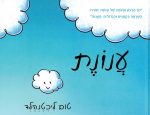ענונת
מאת: טום ליכטנפלד | איור: טום ליכטנפלד
תרגום לאנגלית של ההצעות לפעילות בחיק המשפחה
Cloudette / Written and illustrated by Tom Lichtenheld
Cloudette wants to do big and important things. She embarks upon a journey in which she discovers how small clouds are capable of great changes. This story is about the anticipation for rain, and how both great and small can influence the world. As Israeli singer and songwriter Arik Einstein wrote: "one drop joins another to form the sea".
"And bestow blessed dew and rain upon the face of the entire earth" (from the
Amidah prayer])
Throughout history, the inhabitants of the Land of Israel have awaited and been thankful for rain. In the days when most dwellers were farmers, they prayed for rain to water the earth and help their crops grow. To this day, despite technological advances, we anticipate rain each year, looking up to heaven, following the clouds, measuring the Sea of Galilee level using a series of red lines, and comparing rainfall to multi-annual quantities recorded.
But along with the quantity of rain, it is equally important to have it dispersed across the country, and throughout the season. The term "blessed rain" describes the adequacy between human needs and rainfall, and like it, the story of Cloudette demonstrates the importance of befitting giving with needs and ability to accept. This story also shows us how a small deed can bring great blessing.
Family Activities:
You may want to re-read the beginning of the story together, and be reminded of the advantages of being a small cloud. Perhaps later you would enjoy discussing your child's size with them, and mention things that only little children can do.
Despite the advantages of being small, and her friends' positive attitude towards her, Cloudette wants more. You may want to discuss wishes and desires: is there anything your child wants to do but has yet to try? Is there anything they would like to do but are unable to due to their age or size? You could make a list of desires together. Perhaps some of them can already be fulfilled!
When Cloudette hears "Ribbit" and sees the dry puddle, she realizes what she can do. You could ask your child whether we always know how to help others, and share stories of help given to another, or how others have helped you exactly at the right time using just the right kind of help.
You may like to notice the bigger clouds' nicknames for Cloudette, and how they treat her. They do not tease her, but instead accept her the way she is and like her. Following the story, you may want to discuss nicknames with your child, the various relationships between those older and younger, and the desire to be "a big kid".
Do you like the rain? Following the story, you may want to ask your child whether they like the rain and why, who needs rain, and who enjoys it. Do you know other stories, songs and tales about the rain? You may enjoy curling up together in a warm corner of the house and telling rain stories.
Perhaps you would like to create a rainwater receptacle together. Remove the top part of a plastic bottle by cutting across it (watch out for sharp edges!), place the empty bottle in an open space near your home, or hang it on a wire outside your window. How long did it take it to fill up with rain? Your child may enjoy monitoring the level of water in the bottle, and deciding how to use the rainwater collected.
Enjoy reading and discussing the book together!






